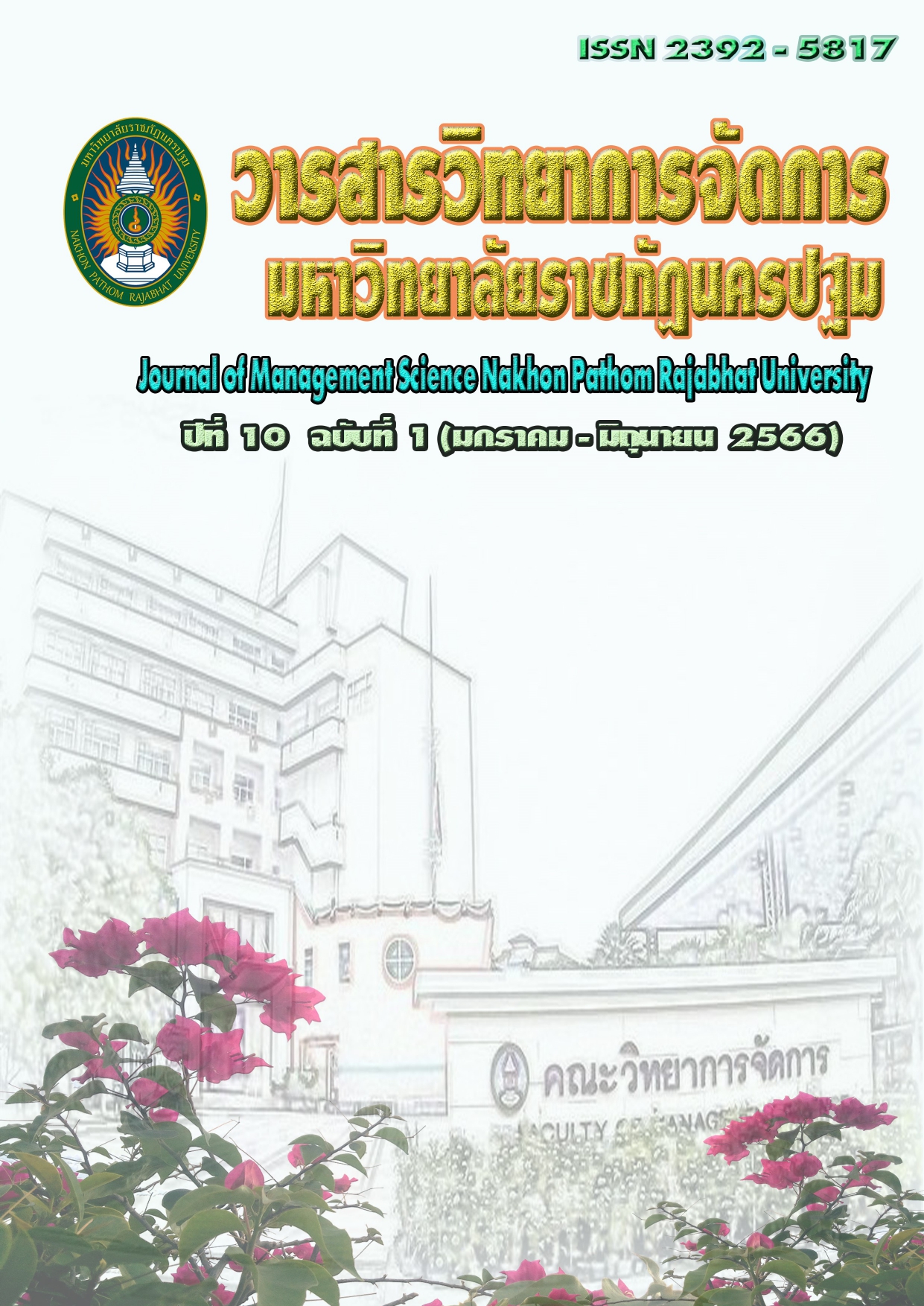หลักเกณฑ์ที่เหมาะสมต่อการประเมินศูนย์การเรียนรู้พื้นที่ต้นแบบการพัฒนาคุณภาพชีวิต ตามหลักทฤษฎีใหม่ ประยุกต์สู่ “โคก หนอง นา โมเดล”
Main Article Content
บทคัดย่อ
การวิจัยครั้งนี้มีวัตถุประสงค์เพื่อ 1) เพื่อศึกษาองค์ประกอบการขับเคลื่อนของศูนย์การเรียนรู้พื้นที่ต้นแบบการพัฒนาคุณภาพชีวิตตามหลักทฤษฎีใหม่ประยุกต์สู่โคก หนอง นา โมเดล 2) เพื่อจัดทำหลักเกณฑ์การประเมินศูนย์การเรียนรู้พื้นที่ต้นแบบการพัฒนาคุณภาพชีวิตตามหลักทฤษฎีใหม่ประยุกต์สู่โคก หนอง นา โมเดล 3) ปัญหาอุปสรรคและหาข้อเสนอแนะในการขับเคลื่อนพื้นที่ศูนย์การเรียนรู้ชุมชนต้นแบบการพัฒนาคุณภาพชีวิต พื้นที่ทำการวิจัย จังหวัดกาญจนบุรี โดยใช้ระเบียบวิธีวิจัยแบบผสานวิธี ในการวิจัยเชิงปริมาณ กลุ่มตัวอย่าง ได้แก่ ผู้เข้าร่วมโครงการพัฒนาพื้นที่ต้นแบบการพัฒนาคุณภาพชีวิตตามหลักทฤษฎีใหม่ ประยุกต์สู่ “โคก หนอง นา โมเดล” จำนวน 164 คน เก็บรวบรวมข้อมูลด้วยแบบสอบถาม และวิเคราะห์ข้อมูลด้วยสถิติเชิงพรรณนา สำหรับการวิจัยเชิงคุณภาพผู้ให้ข้อมูลหลัก จำนวน 15 คน ประกอบด้วย ผู้บริหารระดับกรม/จังหวัด/อำเภอ เจ้าหน้าที่ผู้รับผิดชอบ เจ้าของแปลงตัวอย่างที่เข้าร่วมโครงการฯ ประชาชนในพื้นที่ และนักวิชาการ โดยเครื่องมือที่ใช้ในการวิจัย ได้แก่ แบบสัมภาษณ์เชิงลึก โดยวิเคราะห์ข้อมูลด้วยวิธีการวิเคราะห์เนื้อหา
ผลการวิจัย พบว่า (1) องค์ประกอบของโครงการต่อแนวทางการขับเคลื่อนพัฒนาพื้นที่เรียนรู้ชุมชนต้นแบบการพัฒนาคุณภาพชีวิตมีความสำคัญกับการเป็นศูนย์การเรียนรู้ต้นแบบ โดยภาพรวมแล้วประเด็นทั้ง 4 ด้าน ด้านสังคม ด้านความรู้ ด้านพื้นที่ ด้านกระบวนการ มีความสำคัญอยู่ในระดับมาก 2) นำไปสู่การสร้างหลักเกณฑ์การประเมินศูนย์การเรียนรู้พื้นที่ต้นแบบการพัฒนาคุณภาพชีวิตตามหลักทฤษฎีใหม่ ประยุกต์สู่ “โคก หนอง นา โมเดล” ที่มีความสำคัญ คือ สถานที่ คน ผลผลิต/ผลิตภัณฑ์ การตลาด/ประชาสัมพันธ์ และการบริหารจัดการ (3) สภาพปัญหาพบว่า เรื่องของการขาดความรู้ความเข้าใจ ไม่มีบุคลากรที่เชี่ยวชาญในด้านออกแบบพื้นที่ ผลกระทบจากภัยธรรมชาติ รวมถึงระยะเวลาในการขับเคลื่อนโครงการฯ ที่น้อย ไม่สอดคล้องกับระยะเวลาการขุดปรับรูปแบบแปลงที่ดินให้แล้วเสร็จ โดยมีข้อเสนอแนะ คือ ควรมีการกำกับ ติดตาม สนับสนุนข้อมูลระยะยาว ในการพัฒนาขยายผลกิจกรรมในพื้นที่ตามสภาพภูมิสังคมให้เกิดความสมบูรณ์และยั่งยืน
* นักประชาสัมพันธ์ สำนักงานเลขานุการกรม กรมการพัฒนาชุมชน กระทรวงมหาดไทย,10210
** อาจารย์ มหาวิทยาลัยมหาจุฬาลงกรณราชวิทยาลัย วิทยาลัยสงฆ์นครลําปาง, 52000
Corresponding author: intiyod@hotmail.co.th
Article Details

อนุญาตภายใต้เงื่อนไข Creative Commons Attribution-NonCommercial-NoDerivatives 4.0 International License.
ทัศนะและข้อคิดเห็นของบทความที่ปรากฏในวารสารฉบับนี้เป็นของผู้เขียนแต่ละท่าน ไม่ถือว่าเป็นทัศนะและความรับผิดชอบของกองบรรณาธิการ
เอกสารอ้างอิง
กรมการพัฒนาชุมชน. (2564). ชุดข้อมูลด้านการพัฒนาชุมชนและเศรษฐกิจฐานราก. [ออนไลน์].ค้นเมื่อ 30 เมษายน 2565 จาก https://data.go.th/blog/datasetcommunity
กรมการพัฒนาชุมชน. (2565).ร่างรายงานสรุปผลการดำเนินงาน โครงการพัฒนาพื้นที่ต้นแบบการพัฒนาคุณภาพชีวิตตามหลักทฤษฎีใหม่ ประยุกต์สู่ “โคก หนอง นาโมเดล”.กรุงเทพมหานคร: กรมการพัฒนาชุมชน
กรมทรัพยากรธรณี. (2562). ข้อมูลพื้นที่เสี่ยงภัยจากดินถล่ม น้ำป่าไหลหลากและน้ำท่วมฉับพลัน ประเทศไทย. กรุงเทพมหานคร: กองธรณีวิทยาสิ่งแวดล้อม.
คมสันต์ หุตะแพทย์. (2558). โคก หนอง นา โมเดล หยุดท่วม หยุดแล้ง นวัตกรรมจัดการน้ำสู้วิกฤติ. เกษตรกรรมธรรมชาติ.17(9). 25-28.
ณรัชช์อร ศรีทอง. (2556). แนวคิด หลักการและการปฏิบัติ ตามหลักปรัชญาของเศรษฐกิจพอเพียง. กรุงเทพมหานคร: โอเดียนสโตร์.
ปริยกร เพชรลำรุง (2558). ศูนย์เรียนรู้เศรษฐกิจพอเพียงกับการสร้างความเข้มแข็งให้กับชุมชน:ศึกษากรณี ศูนย์เรียนรู้เศรษฐกิจพอเพียงชุมชน ตำบลโมถ่าย อำเภอไชยา จังหวัดสุราษฎร์ธานี. กรุงเทพมหานคร: รายงานการวิจัย มหาวิทยาลัยรามคำแหง.
มาริษา ศรีษะแก้ว และสถาพร วิชัยรัมย์. (2563). เศรษฐกิจพอเพียง : แนวทางการพัฒนาอย่างยั่งยืน ในประเทศไทย. วารสารสหวิทยาการจัดการ คณะวิทยาการจัดการ มหาวิทยาลัยราชภัฏบุรีรัมย์. 4 (2).39-48.
รัตนะ บัวสนธ. (2556). การประเมินโครงการ:การวิจัยเชิงปริมาณ. กรุงเทพมหานคร: :คอมแพคปริ๊น.
รัฐพงศ์ สีแสด.(2556). การประเมินโครงการศูนย์การเรียนรู้เศรษฐกิจพอเพียงชุมชน กรณีศึกษษศูนย์เรียนรู้เศรษฐกิจพอเพียงชุมชนแห่งหนึ่งในภาคตะวันออก. กรุงเทพมหานคร:รายงานการวิจัย มหาวิทยาลัยเกษตรศาสตร์.
รัชนีวรรณ จีนธรรม, ปัณณ์รภัส ถกลภักดี และอรวรรณ ภัสสรศิริ. (2561). การพัฒนารูปแบบการจัดการเรียนรู้สิ่งแวดล้อมตามหลักปรัชญาของเศรษฐกิจพอเพียงของเครือข่ายกสิกรรมธรรมชาติ. วารสาร มจร พุทธปัญญาปริทรรศน์ มหาวิทยาลัยราชภัฏวไลยอลงกรณ์ในพระบรมราชูปถัมภ์. 3(2).238-248.
วิวัฒน์ ศัลยกำธร. (2558). โคก-หนอง-นา-โมเดล การสร้างวิถีชีวิตที่ยั่งยืน. [ออนไลน์].ค้นเมื่อ 28 เมษายน 2565 จาก http://lugean25042017.blogspot.com/2015/04/blog-post_6.html).
โศภิต นาสืบ. (2564). รายงานผลกระทบเชิงเศรษฐกิจและสังคมจากการระบาดของโรคโควิด-19 ในระดับโลก และในประเทศไทย. [ออนไลน์].ค้นเมื่อ 15 เมษายน 2565 จาก https://ddc.moph.go.th/
uploads/publish/1177420210915075055.pdf
ศิวราภรณ์ ไชยบุรี. (2555). ปัจจัยที่ส่งผลต่อความสำเร็จของศูนย์การเรียนรู้เศรษฐกิจพอเพียง ชุมชนบ้านทาป่าเปา ตำบลทาปลาดุก อำเภอแม่ทา จังหวัดลำพูน. ขอนแก่น: รายงานการวิจัย มหาวิทยาลัยขอนแก่น.
สำนักงานคณะกรรมการพิเศษเพื่อประสานงานโครงการอันเนื่องมาจากพระราชดำริ (สำนักงาน กปร.). (2552). เศรษฐกิจพอเพียงแนวคิดสู่การประยุกต์ใช้ที่ยั่งยืน. กรุงเทพมหานคร. บริษัท เอเชีย แปซิฟิค ออฟเซ็ท จำกัด.
สุกัญญา ดวงอุปมา ภัทราพร ภาระนาค และปารีณา แอนเดอร์สัน. (2558). การส่งเสริมและพัฒนาศักยภาพอย่างยั่งยืนของครัวเรือนเกษตรกรตามหลักปรัชญาของเศรษฐกิจพอเพียง : กรณีศึกษาบ้านโนนสง่า ตำบลหนองกุงจังหวัดกาฬสินธุ์. กาฬสินธุ์: รายงานการวิจัย มหาวิทยาลัยกาฬสินธุ์.
อภิชัย พันธเสน. (2557). เหลียวหลังเพื่อการขับเคลื่อนเศรษฐกิจพอเพียงในทศวรรษหน้า (2556 – 2565). กรุงเทพมหานคร: สำนักงานกองทุนสนับสนุนการวิจัย.
Stufflebeam, D.l.,(2002). CIPP evaluation model checklist: Atool for applying the fifth installment of the CIPP model to assess long-tern enterprises. Retrieved April 11, 2022 from http://www.wmich.edu/evalctr/checklist/cippcheck.htm.
Yamane, T. (1973). Statistics: An Introduction Analysis. New York: Harper International Edition.

